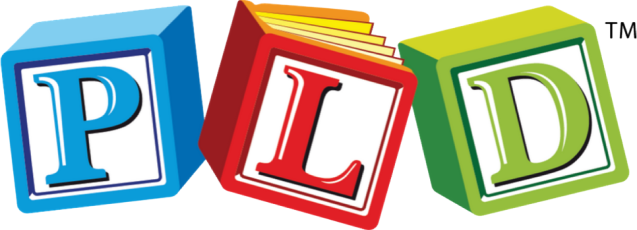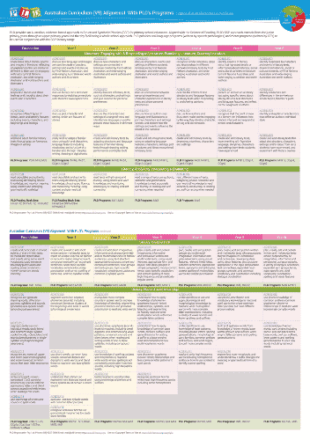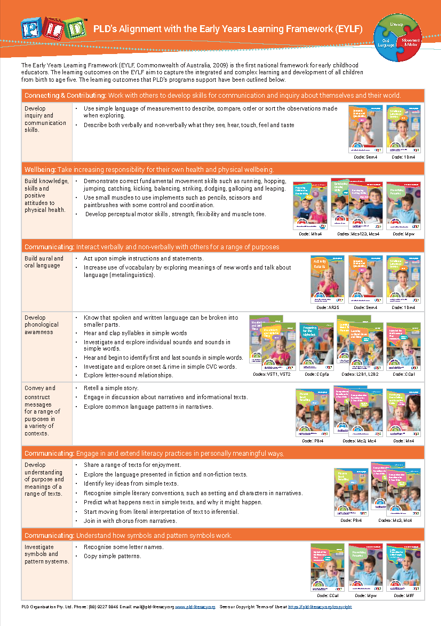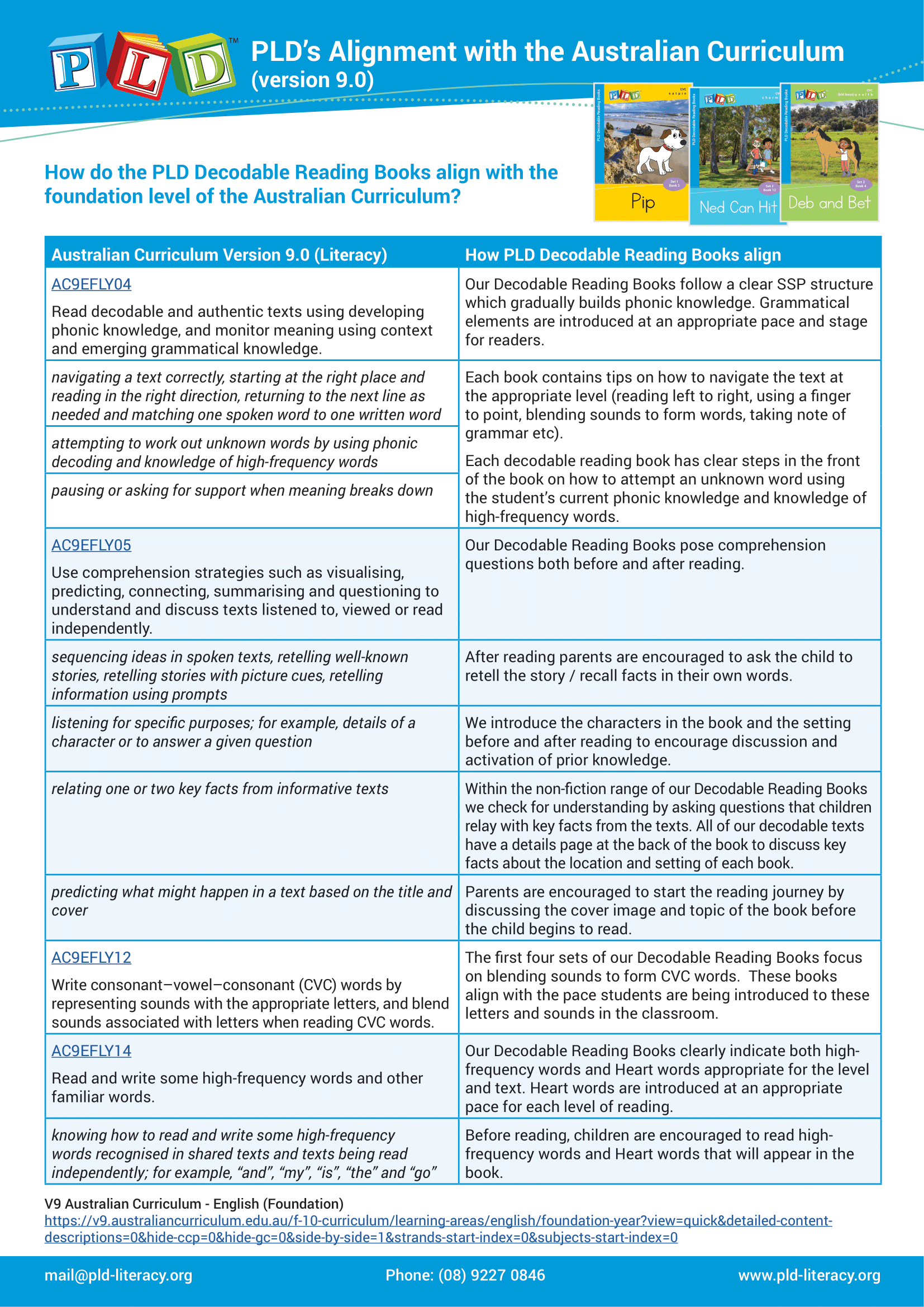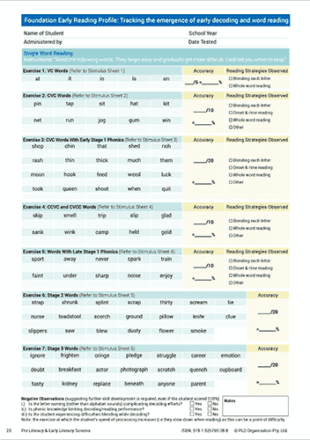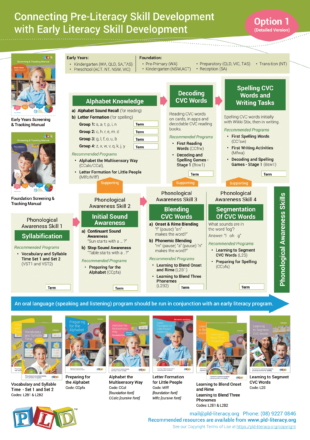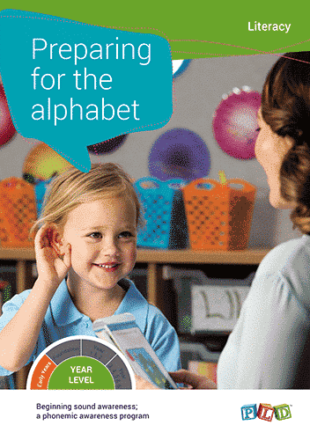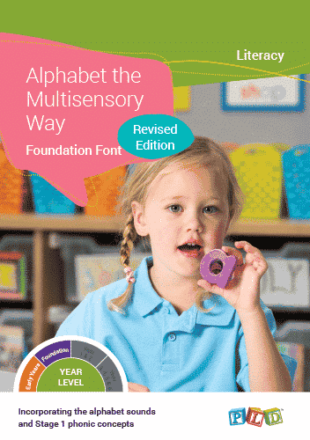-
PLD’s Alignment to the Australian National Curriculum
How does PLD align to the Australian National Curriculum?In the attached download we have outlined where PLD applies to each year level, the content code and descriptor and the related PLD programs.
-
PLD’s Alignment with the Early Years Learning Framework
-
PLD's Decodable Reading Books Alignment with the Australian Curriculum
Preparing for Reading
$82.50 (inc. $7.50 GST)
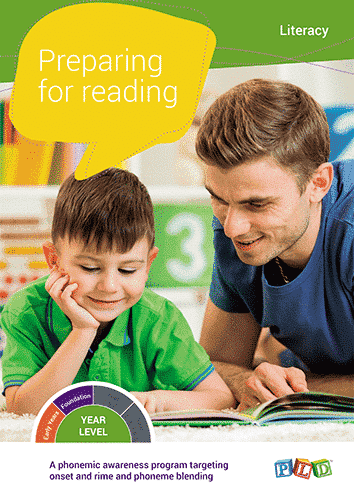

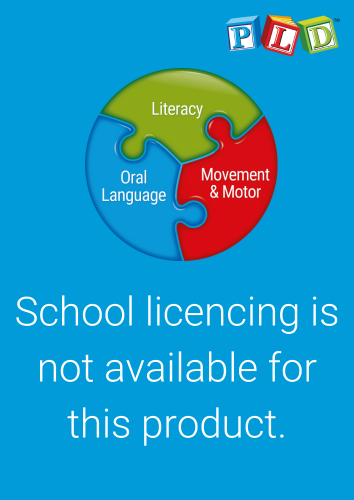
A phonemic awareness program for 4 and 5 year olds targeting CVC blending.
One of the most significant pre-requisites for reading, spelling and writing is phonemic awareness. Phonemic awareness is strongly associated with early literacy achievement. In Preparing for reading for 4 and 5 year olds, blending is targeted as blending represents an immediate precursor to decoding ability. This resource contains coloured card sets recommended for explicit 5 minute instruction sessions and provide clear guidelines on how to effectively teach blending. These instructions can form the basis of assistant and parent education.
The PLD developmental 5 step phonological awareness process has been designed by Speech Pathologists for use in schools. When used in conjunction with PLD’s pre-literacy screening, this program forms a significant component in a school’s preventative early intervention strategy.
Phonemic Awareness Readiness for Reading
The phonemic awareness pre-requisite skill involved in reading simple regular CVC [consonant-vowel-consonant] words such as ‘fig’, ‘tin’ and ‘mat’ is the skill of blending.
- First students must learn to blend at an onset and rime level. E.g. ‘Listen carefully and put these sounds together and guess this word:’ ‘f’ (one second pause) ‘ig’?’
- Students then learn to blend at the phonemic or individual sound level: E.g. ‘Listen carefully and put these sounds together and guess this word; ‘m’ (one second pause) ‘a’ (one second pause) ‘t’? Answer: ‘mat’.
Features:
- Instruction manual (24 pages)
- 5 different blending activities with instructions
- 125+ colour cards, 3 x game boards
The programs within the range include:
This product is mentioned in the Early Years Teaching Sequence Manual on page 8 and the Foundation Teaching Sequence Manual on page 7 and the Year 1 & 2 Teaching Sequence Manual on page 19.
Generous discounts apply for bulk orders
- 5 to 9 copies – 15% discount applies
- 10+ copies – 20% discount applies
Preparing for Reading - eBook
$65.00 (inc. $5.91 GST)



eBooks are solely for use by a single individual user. e.g. An individual classroom teacher. Learn more.
A phonemic awareness program for 4 and 5 year olds targeting CVC blending.
One of the most significant pre-requisites for reading, spelling and writing is phonemic awareness. Phonemic awareness is strongly associated with early literacy achievement. In Preparing for reading for 4 and 5 year olds, blending is targeted as blending represents an immediate precursor to decoding ability. This resource contains coloured card sets recommended for explicit 5 minute instruction sessions and provide clear guidelines on how to effectively teach blending. These instructions can form the basis of assistant and parent education.
The PLD developmental 5 step phonological awareness process has been designed by Speech Pathologists for use in schools. When used in conjunction with PLD’s pre-literacy screening, this program forms a significant component in a school’s preventative early intervention strategy.
Phonemic Awareness Readiness for Reading
The phonemic awareness pre-requisite skill involved in reading simple regular CVC [consonant-vowel-consonant] words such as ‘fig’, ‘tin’ and ‘mat’ is the skill of blending.
- First students must learn to blend at an onset and rime level. E.g. ‘Listen carefully and put these sounds together and guess this word:’ ‘f’ (one second pause) ‘ig’?’
- Students then learn to blend at the phonemic or individual sound level: E.g. ‘Listen carefully and put these sounds together and guess this word; ‘m’ (one second pause) ‘a’ (one second pause) ‘t’? Answer: ‘mat’.
Features:
- Instruction manual (24 pages)
- 5 different blending activities with instructions
- 125+ colour cards, 3 x game boards
The programs within the range include:
This product is mentioned in the Early Years Teaching Sequence Manual on page 8 and the Foundation Teaching Sequence Manual on page 7 and the Year 1 & 2 Teaching Sequence Manual on page 19.
Generous discounts apply for bulk orders
- 5 to 9 copies – 15% discount applies
- 10+ copies – 20% discount applies
eBooks are solely for use by a single individual user. e.g. An individual classroom teacher. Australian Copyright laws prohibit illegal distribution, storage or sharing of this eBook. Usage is tracked and breaches may result in prosecution. Learn more.
If you would like to provide multiple users with access to this resource we suggest selecting the 'Whole School Access' tab at the top of the screen to purchase a School Licence. Learn more.
Preparing for Reading – School Licence



This product is currently not available as a School Licence.
A School Licence is a multi-user subscription to a PLD resource, such as a book or program, in a digital and printable format that is available on all devices.
A School Licence is valid for 12 months from the date of purchase and can be used by an unlimited number of teachers within a school.
To read more about school licencing and to view the full range of licenced publications select PLD School Licences
Below you will find a range of FAQ'S related to school licences:
- What is a PLD School Licence?
- What are the benefits of a School Licence?
- What PLD resources are available to buy under a School Licence?
- Who should purchase the School Licence?
- How do I purchase a School Licence?
- How do I add a teacher to a School Licence?
- How do I remove a teacher from a School Licence?
- I don’t know whether to buy a School Licence or an EBook.
- Can I share my School Licence with teachers from other schools?
- Can I store a school licened resource on my school’s server?
- Can I print out copies of the digital versions?
Books: PLD’s books may only be used by the Authorised Purchaser, and the Authorised Purchaser’s students, and only in conjunction with classes taken by the Authorised Purchaser. PLD’s books may be photocopied up to 10% per year for use only by the Authorised Purchaser. The Authorised Purchaser is defined as the original purchaser of the PLD materials.
eBooks: PLD’s eBooks may only be used by the Authorised Purchaser, and the Authorised Purchaser’s students, and only in conjunction with classes taken by the Authorised Purchaser. The Authorised Purchaser is defined as the original purchaser of the PLD eBook. Under the ‘Statutory Educational Licence’ the authorised purchaser can:
- View the eBook as a whole or in part
- Copy the eBook to their personal drive or locally on their device
- Display the eBook on your Interactive Whiteboard, projector or smart TV, for the purpose of teaching the students in their own classroom
- Photocopy or print up to 10% of the eBook per year, for use with the students in their classroom(s).
For copyright purposes, every page of the PLD eBooks will be stamped with the name & email address provided by the purchaser at the time of order. PLD ebooks belong solely to the purchaser and may not be shared with colleagues, parents or anyone else. PLD eBooks must not be uploaded to school servers, intranets or online platforms. Schools wishing to licence PLD eBooks can contact us HERE.
School Licences: A School Licence is a multi-user subscription to a PLD resource, such as a book or program, in a digital and printable format that is accessible via the ‘My Subscription’ section of the PLD website. A School Licence is valid for 12 months from the date of purchase and can be used by an unlimited number of teachers within a school. When bought under a School Licence:
- Resources are accessible in digital, flipbook format, which teachers can access from anywhere, at any time, on any device via the PLD website.
- The resources can be used by any amount of teachers in that school.
- Multiple teachers can access the resources simultaneously.
- The resource is available to print, subject to the standard 10% per year limitation as per Australian Copyright law.
- Updated versions of resources will be automatically accessible to users with a current licence for free, ensuring all users have access to the latest versions of resources.
- Resources are stored centrally and accessed via a secure login account on the PLD website. Thus, all currently subscription resources are accessible in the one convenient place, making resources extremely easy to find. Moreso, the school licence offering eradicates the frustration of lost or misplaced resources and programs which happens often with hardback books.
Additional information can be accessed via the following links:
Books: https://support.pld-literacy.org/en-au/article/plds-printed-electronic-materials-how-can-they-be-used-can-i-share-them-with-a-friendcolleague-9lk4y/
eBooks: https://support.pld-literacy.org/en-au/article/the-pld-ebooks-how-can-they-be-used-what-is-the-copyright-policy-ptfya8/
PLD’s Copyright Policy: https://support.pld-literacy.org/en-au/article/copyright-and-terms-of-use-of-pld-literacy-15tkcer/
ISBN :
9 781925 769067
ISBN :
9 781925 769067

